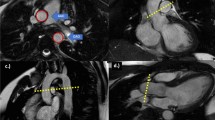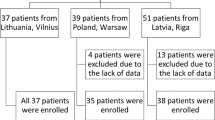Abstract
It is challenging to evaluate aortopathy in congenital heart disease using conventional investigations such as brachial-ankle pulse wave velocity (baPWV). Therefore, we evaluated the cardio-ankle vascular index (CAVI), a dimension of the ascending aorta and plasma transforming growth factor-β1 (TGF-β1) level, in order to find novel noninvasive parameters of aortopathy in adults with repaired tetralogy of Fallot (TOF). Prospectively, we enrolled 42 consecutive adults with TOF (28 patients with repaired TOF were not on ARB, 8 patients with repaired TOF on ARB, 6 patients with no repair or only palliative repair) and 20 age-matched healthy controls. We measured CAVI, baPWV, plasma TGF-β1 level and a diameter of the ascending aorta using echocardiography. The mean age of repaired TOF without ARB were 31.9 ± 9.1 years. An aortic diameter of the ascending aorta, CAVI, and plasma TGF-β1 level were significantly higher in repaired TOF without ARB than those in controls, whereas baPWV did not differ. On a univariate analysis, CAVI, plasma TGF-β1 level and Rastelli procedure were important factors for an aortic diameter of the ascending aorta (r = 0.56, P < 0.01, r = 0.59, P < 0.01, r = 0.39, P < 0.05, respectively) in this population. There was no significant correlation with age, baPWV, NT-pro brain natriuretic peptide (BNP), repair age, shunt duration, aortic regurgitation or right aortic arch. On the other hand, patients with unrepaired or palliative TOF, who had obvious volume overload, showed no significant correlation with CAVI, baPWV or plasma TGF-β1 level. CAVI and plasma TGF-β1 level, not baPWV, correlate to aortopathy in adults with repaired TOF.
Similar content being viewed by others
References
Niwa K (2005) Aortic root dilatation in tetralogy of Fallot long-term after repair–histology of the aorta in tetralogy of Fallot: evidence of intrinsic aortopathy. Int J Cardiol 103(2):117–119
Niwa K, Perloff JK, Bhuta SM, Laks H, Drinkwater DC, Child JS, Miner PD (2001) Structural abnormalities of great arterial walls in congenital heart disease: light and electron microscopic analyses. Circulation 103(3):393–400
Tan JL, Davlouros PA, McCarthy KP, Gatzoulis MA, Ho SY (2005) Intrinsic histological abnormalities of aortic root and ascending aorta in tetralogy of Fallot: evidence of causative mechanism for aortic dilatation and aortopathy. Circulation 112(7):961–968
Murakami T, Tateno S, Kawasoe Y, Niwa K (2014) Aortic surgery is one of the risk factors for enhancement of pressure wave reflection in adult patients with congenital heart disease. Int J Cardiol 175(3):451–454
Munakata M, Ito N, Nunokawa T, Yoshinaga K (2003) Utility of automated brachial ankle pulse wave velocity measurements in hypertensive patients. Am J Hypertens 16(8):653–657
Shirai K, Hiruta N, Song M, Kurosu T, Suzuki J, Tomaru T, Miyashita Y, Saiki A, Takahashi M, Suzuki K, Takata M (2011) Cardio-ankle vascular index (CAVI) as a novel indicator of arterial stiffness: theory, evidence and perspectives. J Atheroscler Thromb 18(11):924–938
Gómez-Marcos MÁ, Recio-Rodríguez JI, Patino-Alonso MC, Agudo-Conde C, Gómez-Sánchez L, Gomez-Sanchez M, Rodríguez-Sanchez E, Maderuelo-Fernandez JA, García-Ortiz L, LOD-DIABETES Group (2015) Cardio-ankle vascular index is associated with cardiovascular target organ damage and vascular structure and function in patients with diabetes or metabolic syndrome, LOD-DIABETES study: a case series report. Cardiovasc Diabetol 16(14):7
Nakagawa R, Kuwata S, Kurishima C, Saiki H, Iwamoto Y, Sugimoto M, Ishido H, Masutani S, Senzaki H (2015) Arterial stiffness in patients after Kawasaki disease without coronary artery involvement: assessment by performing brachial ankle pulse wave velocity and cardio-ankle vascular index. J Cardiol 66(2):130–134
Nataatmadja M, West J, West M (2006) Overexpression of transforming growth factor-beta is associated with increased hyaluronan content and impairment of repair in Marfan syndrome aortic aneurysm. Circulation 114(1 Suppl):I371–I377
Matt P, Schoenhoff F, Habashi J, Holm T, Van Erp C, Loch D, Carlson OD, Griswold BF, Fu Q, De Backer J, Loeys B, Huso DL, McDonnell NB, Van Eyk JE, Dietz HC, GenTAC Consortium (2009) Circulating transforming growth factor-beta in Marfan syndrome. Circulation 120(6):526–532
Seki M, Kurishima C, Kawasaki H, Masutani S, Senzaki H (2012) Aortic stiffness and aortic dilation in infants and children with tetralogy of Fallot before corrective surgery: evidence for intrinsically abnormal aortic mechanical property. Eur J Cardiothorac Surg 41(2):277–282
Jeewa A, Manickaraj AK, Mertens L, Manlhiot C, Kinnear C, Mondal T, Smythe J, Rosenberg H, Lougheed J, McCrindle BW, van Arsdell G, Redington AN, Mital S (2012) Genetic determinants of right-ventricular remodeling after tetralogy of Fallot repair. Pediatr Res 72(4):407–413
Kobayashi Y, Saita Y, Nishio H, Ikeda H, Takazawa Y, Nagao M, Takaku T, Komatsu N, Kaneko K (2016) Leukocyte concentration and composition in platelet-rich plasma (PRP) influences the growth factor and protease concentrations. J Orthop Sci 21(5):683–689
Maloney JP, Narasimhan J, Biller J (2016) Decreased TGF-β1 and VEGF release in cystic fibrosis platelets: further evidence for platelet defects in cystic fibrosis. Lung 194(5):791–798
Kushida N, Nomura S, Mimura I, Fujita T, Yamamoto S, Nangaku M, Aburatani H (2016) Hypoxia-Inducible Factor-1α activates the transforming growth factor-β/SMAD3 pathway in kidney tubular epithelial cells. Am J Nephrol 44(4):276–285
Paloschi V, Gådin JR, Khan S, Björck HM, Du L, Maleki S, Roy J, Lindeman JH, Mohamed SA, Tsuda T, Franco-Cereceda A, Eriksson P (2015) Aneurysm development in patients with a bicuspid aortic valve is not associated with transforming growth factor-β activation. Arterioscler Thromb Vasc Biol 35(4):973–980
Acknowledgements
Thanks to Ms. Kanako Hattori and Ms. Kaori Azuma for CAVI measurements.
Author information
Authors and Affiliations
Corresponding author
Ethics declarations
Conflict of interest
The authors declare that they have no conflicts of interest.
Rights and permissions
About this article
Cite this article
Shiina, Y., Niwa, K. Cardio-Ankle Vascular Index (CAVI) and Plasma Transforming Growth Factor-β1 (TGF-β1) Level Correlate with Aortopathy in Adults with Repaired Tetralogy of Fallot. Pediatr Cardiol 38, 338–343 (2017). https://doi.org/10.1007/s00246-016-1519-z
Received:
Accepted:
Published:
Issue Date:
DOI: https://doi.org/10.1007/s00246-016-1519-z




